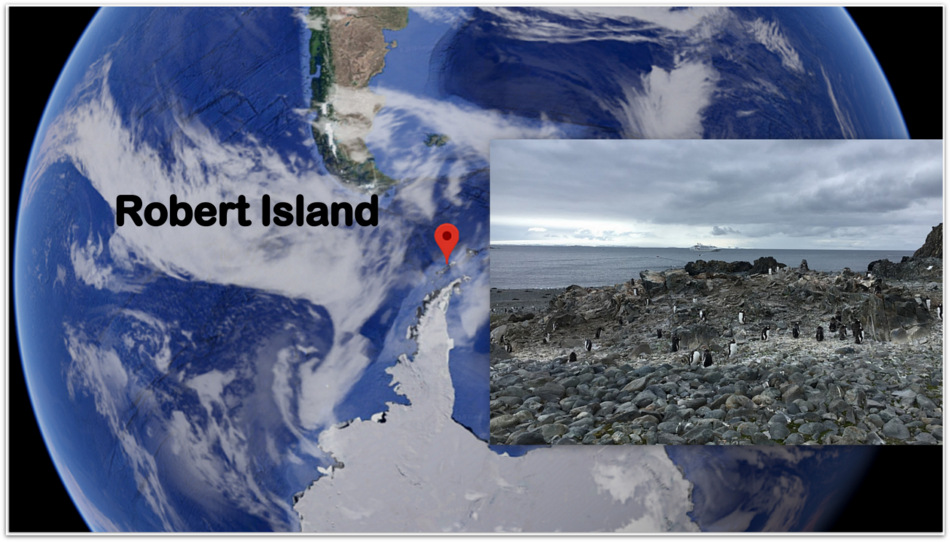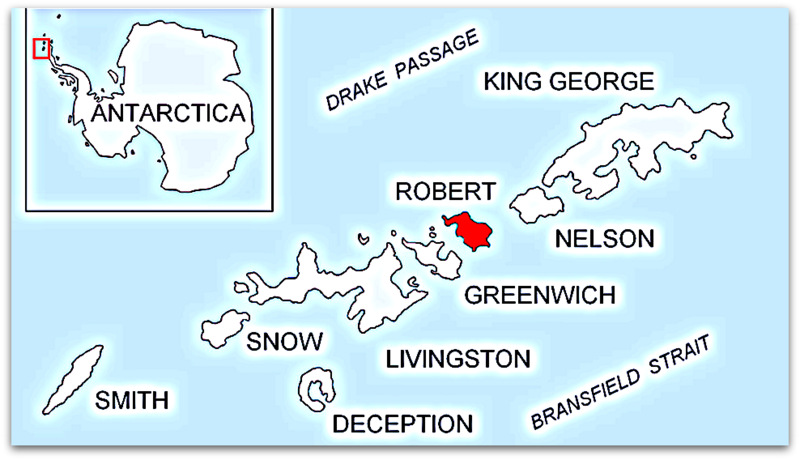During The International Geophysical Year (1956-1958), four Chileans, including two renowned scientists, an assistant and a Navy nurse were dropped by helicopter on Robert Island in Antarctica. They stayed over there for a month in a transportable metallic shelter, with a radio transmitter and its battery, and the material needed to study the region geology, fauna, and flora.
Robert Island is located on the 65th parallel South and on the 60th meridian East in the Wedell Sea, in the Southern Ocean. Due to its volcanic origins, basalt abounds in the island which is about 500 km2 large.
In early January, by stormy weather, the expedition members faced a problem leading to a rescue operation set for the 20th of January: the radio system had shut down making impossible any communication with the rest of the world.
Doctor Tagle (pseudonyms are used at the witnesses’ request) would get up during the conventional night hoping to surprise southern lights. Professor Barros who did not share this habit had forbidden his colleague from waking him up even though all the most beautiful lights in the world might gather in Robert. However, on the 8th of January, Doctor Tagle dared to break his colleague’s sleep. Professor Barros first put on his equipment to face up the 21 degrees Celsius below zero. The sun was shining from the South-East and the cloudless sky displayed its deep blue dome over the peaceful ice. Such fair weather conditions appear to be very rare in the region according to the Navy weather report.
Doctor Tagle pointed at the sky towards the South, right up above his head, and bad-tempered Professor Barros saw two metallic cigar-shaped aircrafts hanging still in a vertical position. One was stationed on the meridian while the other one was standing apart at a 30 degrees distance. They both reflected the sunlight. In spite of Barros’ secret fears emphasized by Tagle’s excitation, he examined the aircraft with his binoculars: its compact aspect and its metallic smooth surface area revealed an artificial origin.
The professors decided not to wake their other colleagues up, so that they could become aware of the phenomenon by themselves. Besides, there might be a remote possibility that both scientists were hallucinating and could contaminate their colleagues if they talked about it. They walked a hundreds kilometers away from the campsite and at seven a.m., the Army nurse came out wearing a t-shirt as he would every morning to do some work out and keep in shape. Almost immediately the scientists heard him scream out: “Sir, Sir, flying saucers!”
The assistant also got up and soon the four men were watching the phenomenon, now convinced it was no illusion. The objects remained still as though they were part and parcel of the sky since ancient times.
Around nine o’clock, the object number one, i.e. the nearest one to the meridian, suddenly took a horizontal position and flew away towards the West in the blink of an eye. It lost its metallic tint to become ultraviolet. It changed its direction turning on a right angle, then followed another way in the sky without stopping and soon took up another direction. It kept on maneuvering dizzyingly zigzagging about: it would brake abruptly, speed up instantaneously, and pass over the observers’ heads always following tangential trajectories in relation to earth. All of it was performed in complete silence. After a five-minutes show, it went to park next to its colleague, taking up its initial position, although with a 50 degrees distance now. Number 2 which had remained still while the other one performed his dance came out of its motionlessness to go towards the east. It executed about ten rough moves, brutally changing direction and showed variations of colors according to whether it accelerated or stopped. After three minutes, it went to station next to its colleague and recovered its metallic aspect.
The expedition has two Geiger counters with high sensitivity, one to measure the audio and the other for scintillation. Once the objects had taken up their initial position, they realized that the scintillation counter showed an ambient radioactivity four times higher, endangering the life of any living being exposed to it for an extended period of time. This finding only increased the expedition members’ fear.
The temperature continued between 15 and 20 degrees below zero and no cloud would alter the skies purity. Nobody could do anything that day, apart from observing the objects. The feeling to have become microorganisms under a microscope, examined by cold invisible eyes kept the men away from focusing on their usual tasks. Even though they did not possess telephoto lens, they took many pictures in colors as well as in black and white.
Barros did not fear an attack from the objects but his scientific rigorously rational mind did not allow him to conceive such phenomenon on the margins of science. While the hours passed by, he was increasingly convinced to be witnessing a non human phenomenon, to be observed by an intelligence that, for some reason, wished to remain anonymous and whose doings were unpredictable.
In the evening, with the intention to get away from that presence, the four expedition members went off to the northern littoral, where the green waters of the Wedell Sea lie. The refuge was located on a moraine – former glacier bed – that rose up at about sixty meters above the sea level. In this way, it did not take much time for the men to be out of sight behind a steep hill. Suddenly, there was a light which vanished in a fraction of a second above the hill, as if it were a maneuver meant to warn them it was useless to hide. It was about nine o’clock p.m. when the men came back to the camp and the objects had not moved.
By the fall of the day, cirrus appeared. In Antarctica, they form at an altitude between 6 and 10 thousands meters and they herald an up-coming storm. Using this data as a reference, Professor Barros calculated with a theodolite the objects’ altitude at about eight thousands meters and their longitude at a hundred and fifty meters. He evaluated the diameter, in its larger part, at twenty-five meters. This data is quite reliable as one of the clouds cast a small shadow over one of the objects. What he had found out enlightened the Professor Barros. He took a polarizer, which is used to determine rocks’ components and other substances requiring a deviation of light, and he orientated its screen towards the objects while turning on the flashlight. Almost immediately number one cast an intense light and once it had turned off, they could see it had notably come down. Its size was that of a small car, i.e. about 3 meters long. Doctor Tagle who had been watching it through binoculars believed he saw some sort of porthole on the top; this fact is not corroborated by Barros.
When the object unexpectedly came down, which seems to be a reaction to the Barros’ signal with the polarizer, Tagle had a nervous breakdown. He kicked and destroyed the polarizer. Number one went back up and started performing revolutions again. These flybys allowed Professor Barros to determine its speed, using the altitude previously estimated and taking account of his new visual angle, at 4000 kilometers per hour, which is the speed of take off from earth. Considering that the objects started from zero to go up that speed instantaneously, and then stopped suddenly without slowing down progressively, the inertia inside the aircraft must have been lethal for any living creature, unless they had their own gravitational field, according to Plantier’s theories on UFO propulsion system.
Around eleven p.m., the blizzard started to blow. It was an Antarctic wind that could reach up to three hundred kilometers per hour. The sky got very cloudy. Around two a.m., in the middle of the windstorm, they realized the radioactivity had dropped. At the same time, the psychological tension decreased. Before they could check it visually, they knew the objects were gone. The next day, the radioactivity had come back to normal. In the afternoon, when the windstorm slowed down and the sky opened up to forty-five per cent, they were able to confirm that the objects were not there any more.
On January 20th, a helicopter came to rescue the four men. Although they did not dare to tell their adventure fearing ridicule, they decided to confess to a Chilean high-ranked Navy officer who was not surprised by their story. The officer knew about many UFO observation cases, recorded in almost every expedition to the Antarctic, though none had been so long and so detailed as that of Barros and Tagle. The ATIC (Air Technical intelligence Center in the U.S.) sent them an extensive questionnaire which Barros and Tagle filled up and developed.

